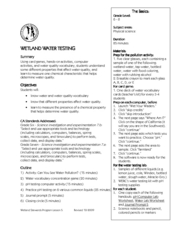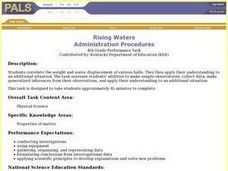Curated OER
Microscopic Water Life
Students use a light microscope to observe the organisms living in a sample of ocean or fresh water. Students create a drawing of the organisms that they observe. Students then discuss the different body plans of the organisms and the...
Biology Junction
Water Biomes
Water covers more than 70 percent of Earth's surface. Scholars learn about both freshwater and saltwater biomes in a simple presentation. They compare and contrast the differences in oxygen levels, food sources, and sunlight to better...
Baylor College
Tools of Magnification
Life science learners need to be able to use a microscope. With this comprehensive resource, they first experience how lenses and magnification work, and then get familiar with using a compound microscope. Tremendous background...
Nuffield Foundation
Observing Water Moving Through Plants
We know plants assist in the water cycle, but how do plants get water from the ground into the air? Through a series of demonstrations or labs, scholars observe the movement of water through plants. They microscopically view the cells...
Curated OER
Wetland Water Testing
Students examine the different properties that affect water quality. For this pollution lesson students play a game, complete a hands on activity and computer lab.
Curated OER
Diatoms of Laboratory Indicators of Water Quality
In this science worksheet, learners use the diatoms present in water in order to test water quality and perform data collection and interpretation.
Curated OER
Plastic Bag Pond
Students investigate the pond water from a local water source. They collect the pond water from the bottom or near vegetation in order to obtain the best sample possible. Then they use microscopes in class in order to examine the life...
Kenan Fellows
Microorganisms in Pond Water
That is living in the water? Groups of two to three view pond water with microscopes in order to find microorganisms. They draw pictures of the ones they find in their slides. The groups compare their drawings to pictures of common pond...
Curated OER
Viewing Bacteria
Have you ever wanted to know the true structure of E.coli? Does the thought of peering into its "small world" sound exciting? Here is a instructional activity that allows pupils the ability to do just that. Blossoming microbiologists use...
Curated OER
Life in a Drop of Pond Water
Students investigate living creatures that inhabit a pond and explore how various organisms satisfy their needs within their environments. In this life in a drop of pond water lesson, students examine microorganisms under magnification....
Curated OER
Time Lapse Seed Germination with the QX3 Intel Digital Microscope
Students use the time-lapse feature of the QX3 Intel Digital Microscope
to observe germination of seeds. They use the QX3 Intel Digital microscope to create time lapse video films of seed germination experiments.
Curated OER
Water Words Puzzle
In this water activity, students fill in the blanks to a crossword puzzle having to do with water words. Students complete 25 blanks in the crossword.
Curated OER
Ecological Succession in Pond Water Cultures
Students collect samples of pond water, dried grass, and soil in a jar. They predict the order of ecological succession in their pond water cultures. They compare their expected results with their observed results.
Curated OER
Microscopes: Is what you see, what you got?
Eighth graders identify the parts and functions of the microscope. In this biology lesson, 8th graders observe different samples under different types of microscopes. They compare and contrast the details they see.
Curated OER
How Can We Study the Differences in Animal and Plant Cells Using the Compound Microscope?
High schoolers examine their cheek cells with a compound microscope. They identify different parts of the cell. They compare and contrast animal and plant cells with the microscope as well.
Curated OER
Rising Waters
Fourth graders rank balls by size from smallest to largest and from lightest to heaviest and then by how much they made the water rise. They then discuss why certain balls make the water rise higher than do other balls.
Curated OER
Reading the River
In collaborative groups, young ecologists measure the temperature, pH, and dissolved oxygen for three different freshwater samples. They examine each sample with a microscope and record observations on the microorganisms in the pond...
Curated OER
Hairy Evidence! Hair Identification
Provide a mystery hair and a set of reference hair samples for middle school investigators to place on a slide and examine under a microscope. Materials and procedures are detailed on the first page, while a data table for drawing what...
Virginia Department of Education
Freshwater Food Chains
What's in the water? Encourage your class to further explore this question and learn about pond ecosystems, food chains, and food webs as they complete this hands-on activity. They view the environment from a new perspective after...
Curated OER
Using Microscopes
Students do an experiment using a microscope. In this lesson, about cells, students examine different slides using a microscope. Students look at an onion skin, cheek cells, and potato cells. In each of these, students find cell walls,...
Curated OER
Water Purification
Learners develop an understanding and appreciation of water purification techniques and their implications for health maintenance.
Curated OER
Water Retention and Soil Variation in Local Ecosystems
Students identify the differences in local soil types and the relationship between soil size and water retention. They are introduced to microenvironmental conditions in ecosystem sustainability.
Curated OER
Examining Pond Life
Students collect and examine microscopic life from a local pond. In this biology lesson, students examine local pond water, searching for protozoa, with the use of a microscope. Students identify the various life forms in their slides...
Curated OER
Plant and Animal Cells - Are they Different?
Students observe the similarities and differences between plant and animal cells. In this cell activity, students use microscopes to observe self prepared slides of animal and plant cells.

























